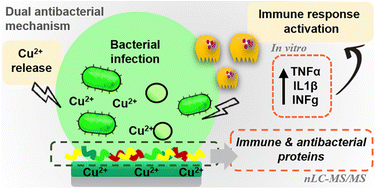Insight into the antibacterial mechanism of Cu-enriched sol–gel coatings employing proteomics†
Abstract
Advanced antibacterial biomaterials can help reduce the severe consequences of infections. Using copper compounds is an excellent option to achieve this goal; they offer a combination of regenerative and antimicrobial functions. In this study, new CuCl2-doped sol–gel coatings were developed and physicochemically characterised. Their osteogenic and inflammatory responses were tested in vitro using human osteoblasts and THP-1 macrophages. Their antibacterial effect was evaluated using Escherichia coli and Staphylococcus aureus. The Cu influence on the adsorption of human serum proteins was analysed employing proteomics. The materials released Cu2+ and were not cytotoxic. The osteoblasts in contact with these materials showed an increased ALP, BMP2 and OCN gene expression. THP-1 showed an increase in pro-inflammatory markers related to M1 polarization. Moreover, Cu-doped coatings displayed a potent antibacterial behaviour against E. coli and S. aureus. The copper ions affected the adsorption of proteins related to immunity, coagulation, angiogenesis, fibrinolysis, and osteogenesis. Interestingly, the coatings had increased affinity to proteins with antibacterial functions and proteins linked to the complement system activation that can lead to direct bacterial killing via large pore-forming complexes. These results contribute to our understanding of the antibacterial mechanisms of Cu-biomaterials and their interaction with biological systems.



 Please wait while we load your content...
Please wait while we load your content...